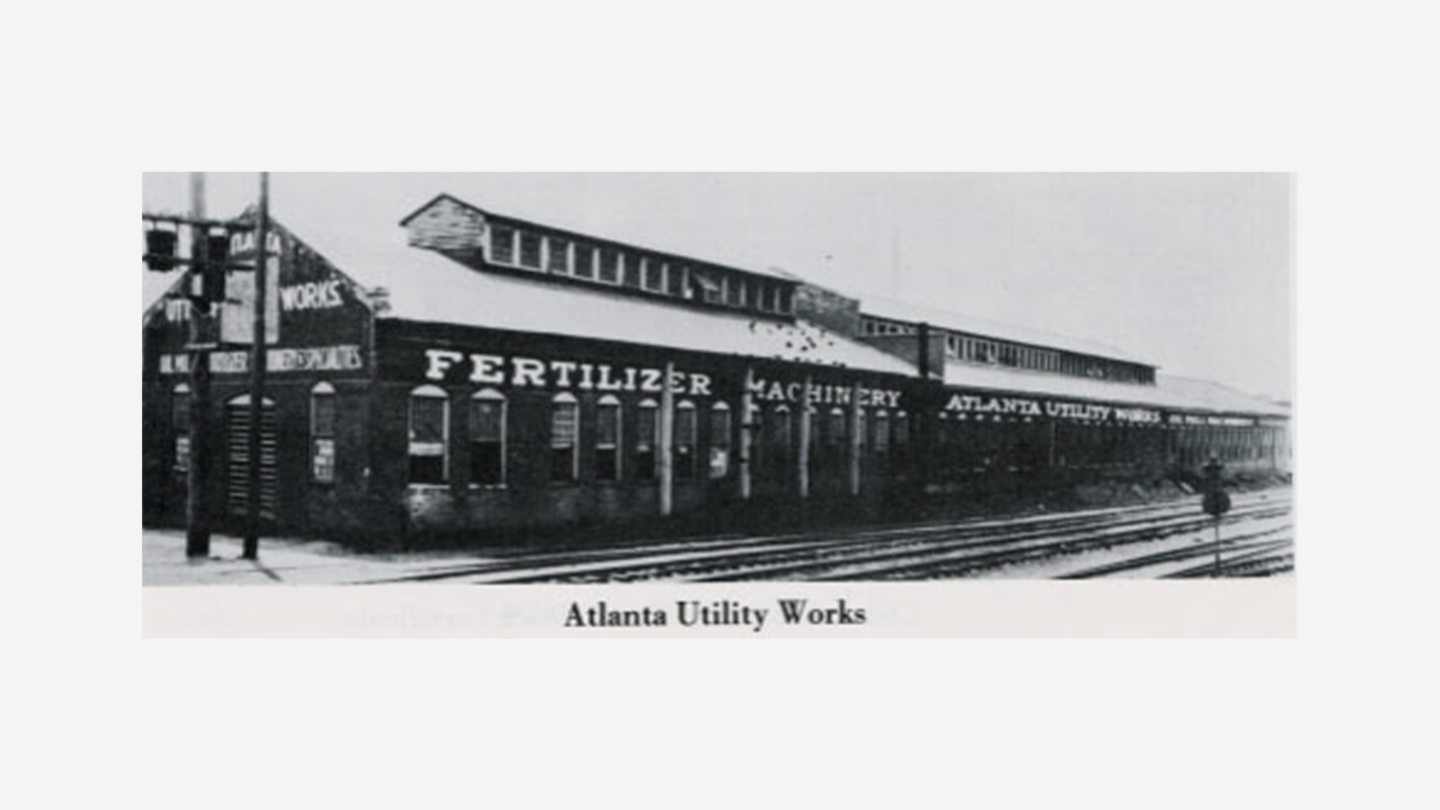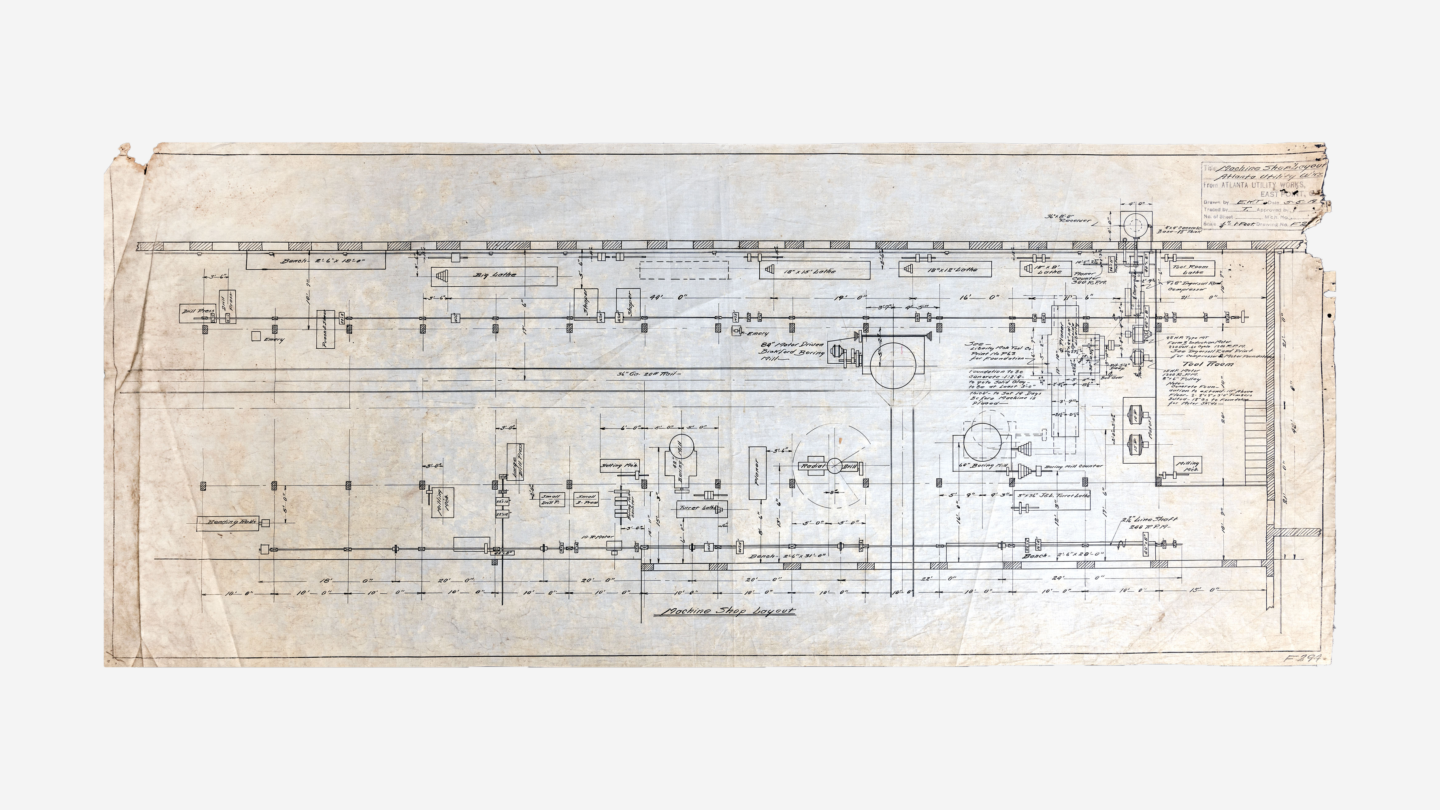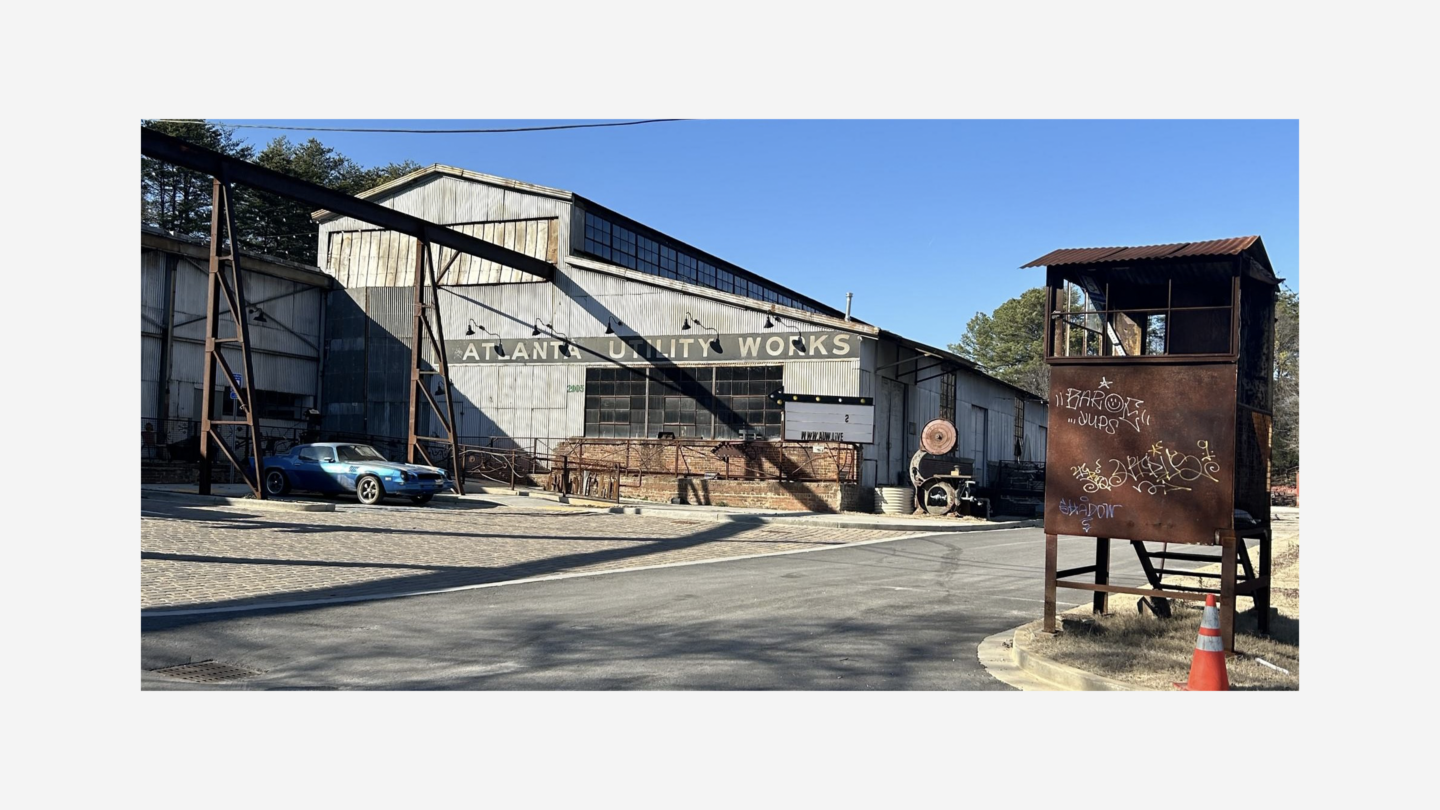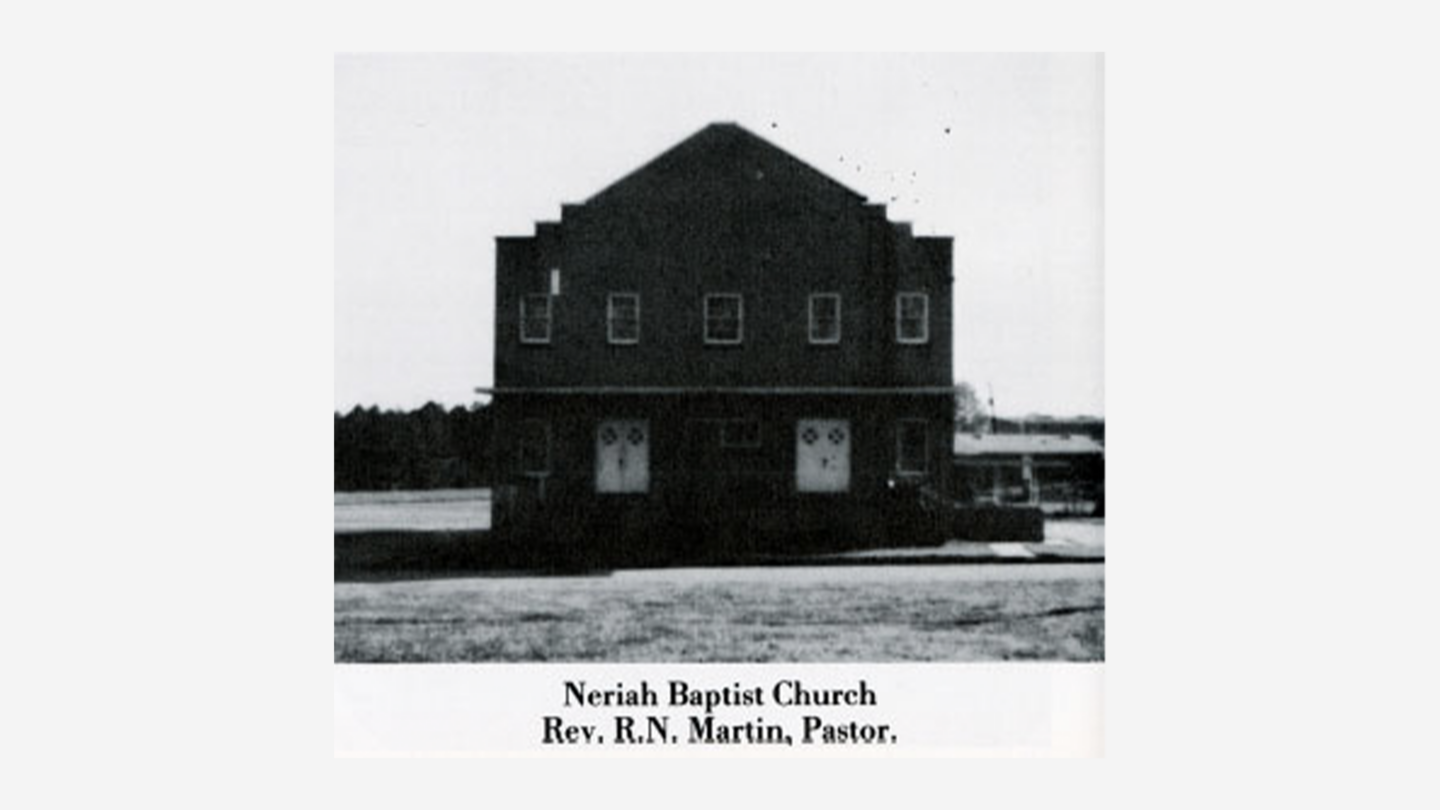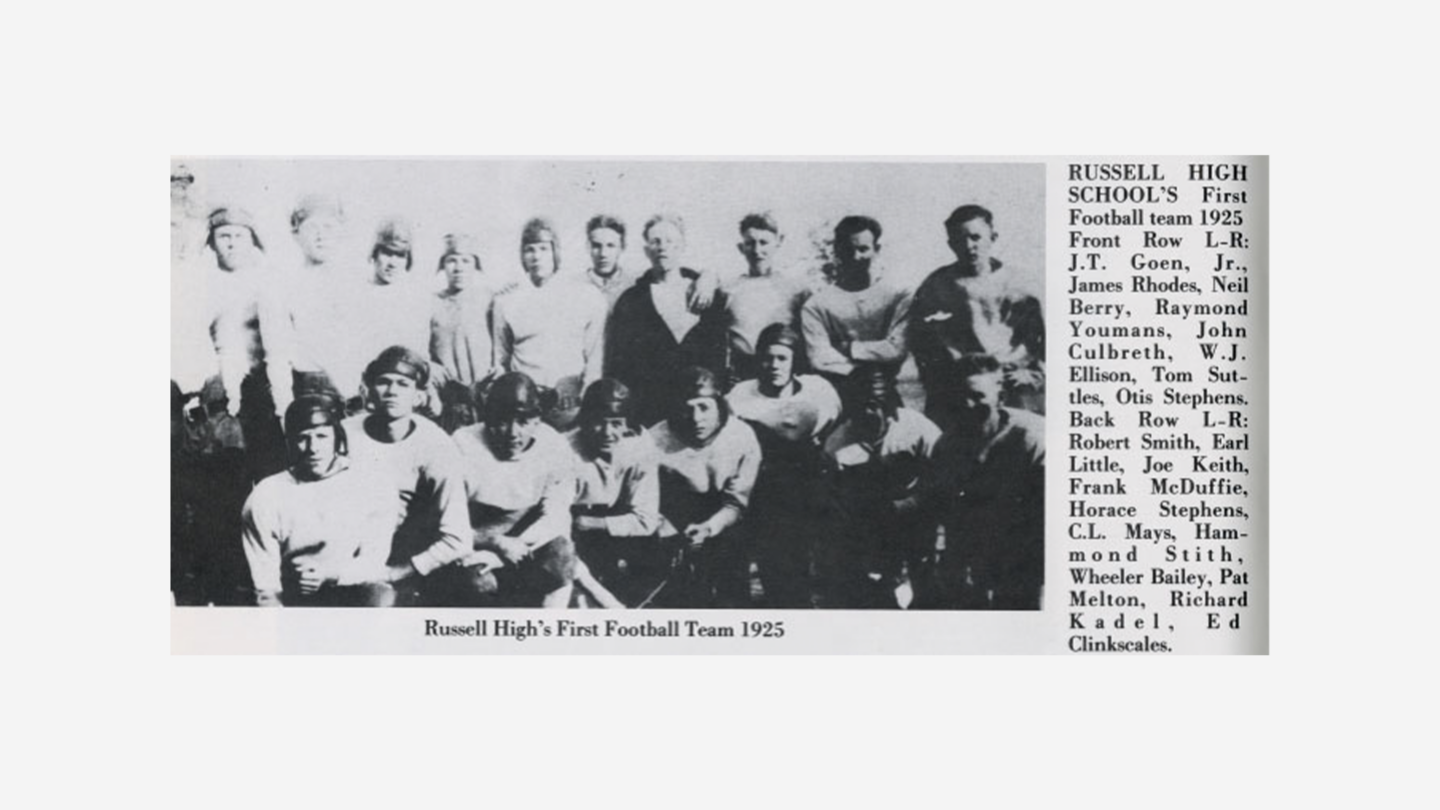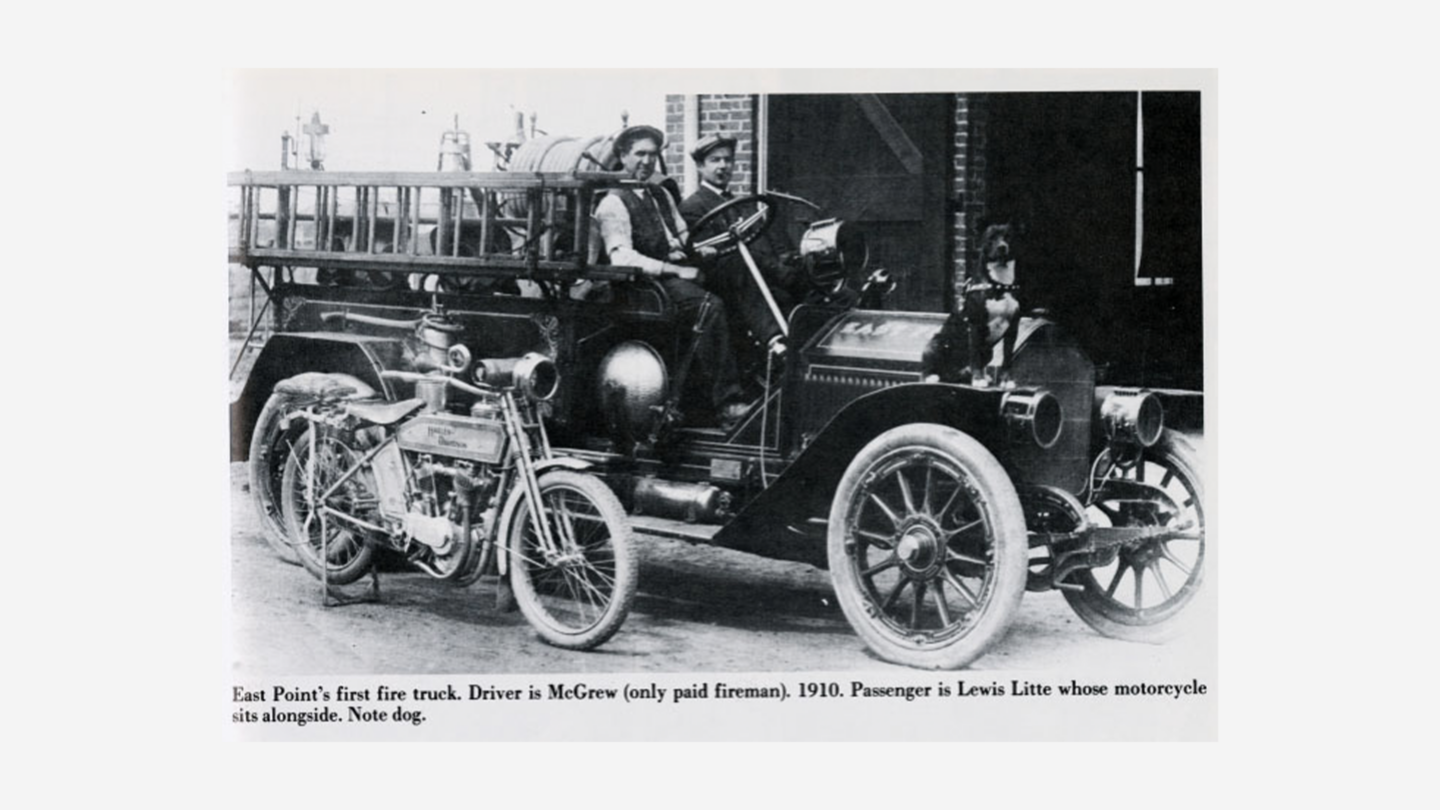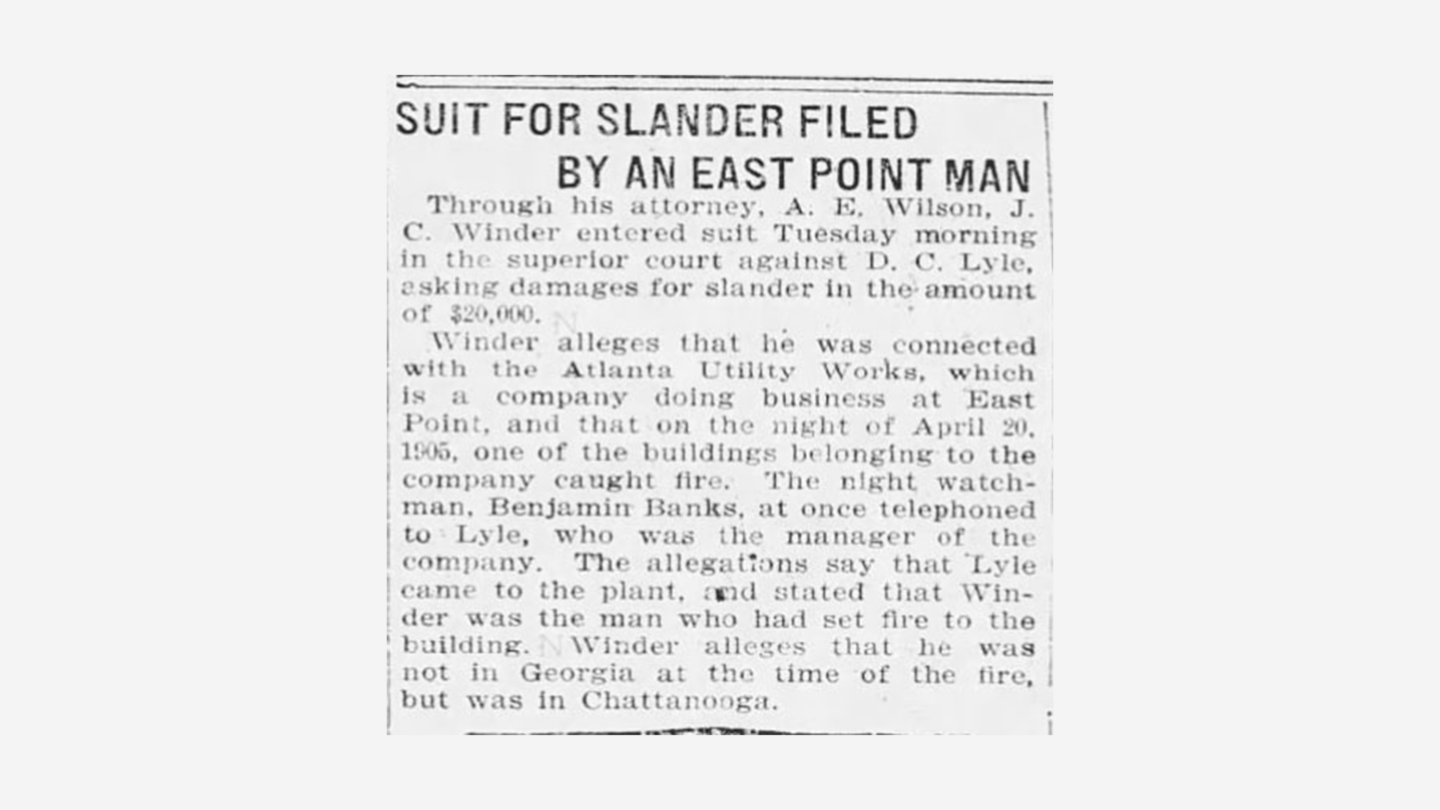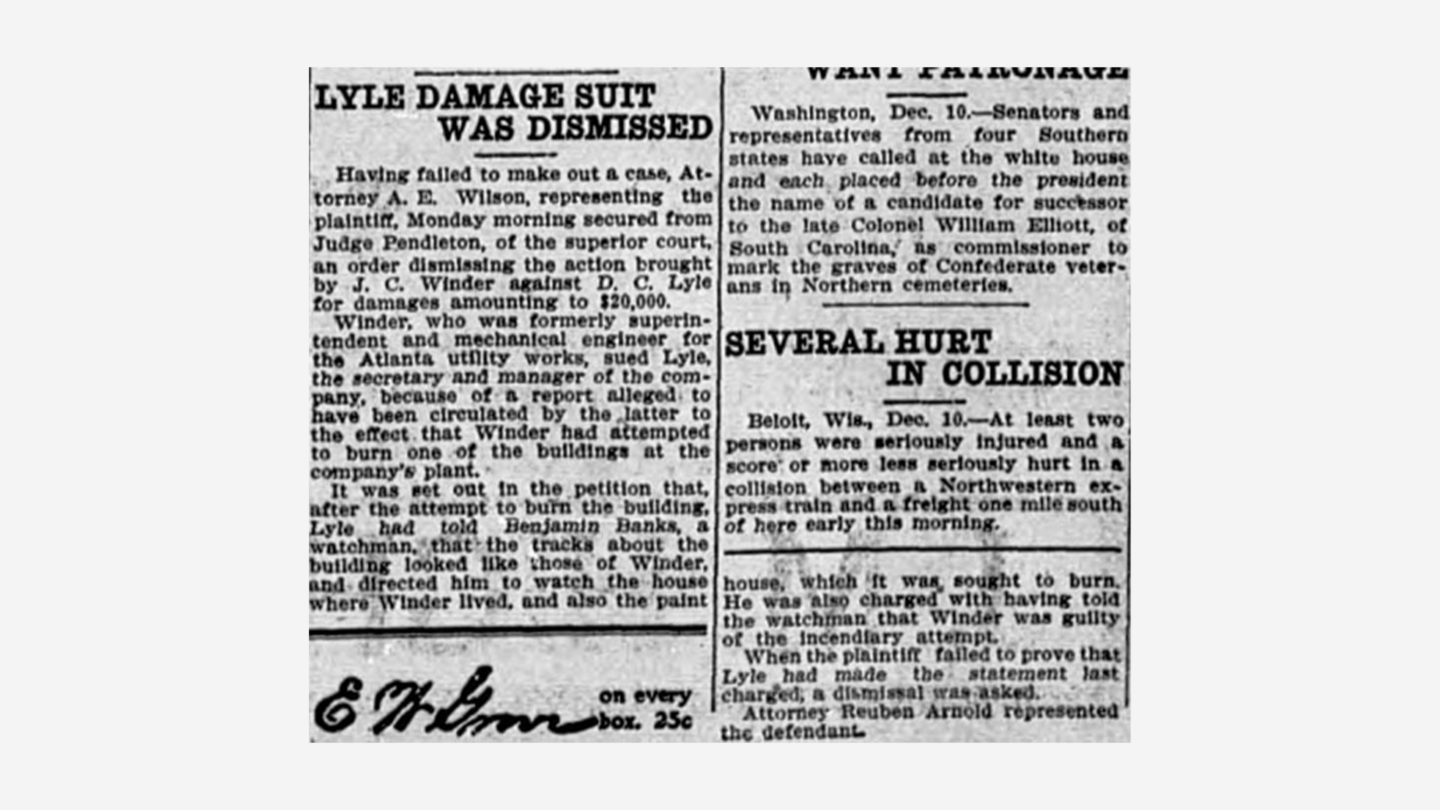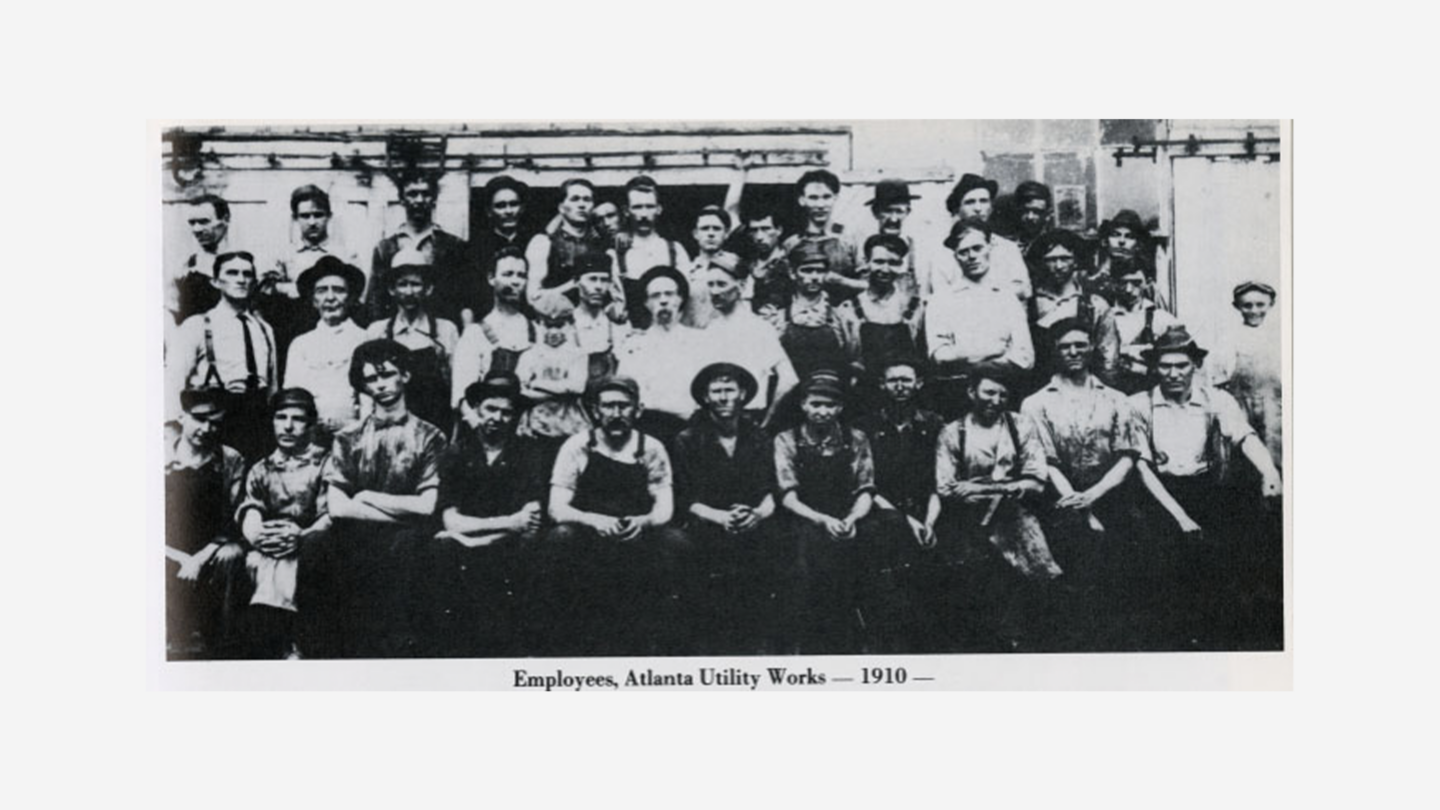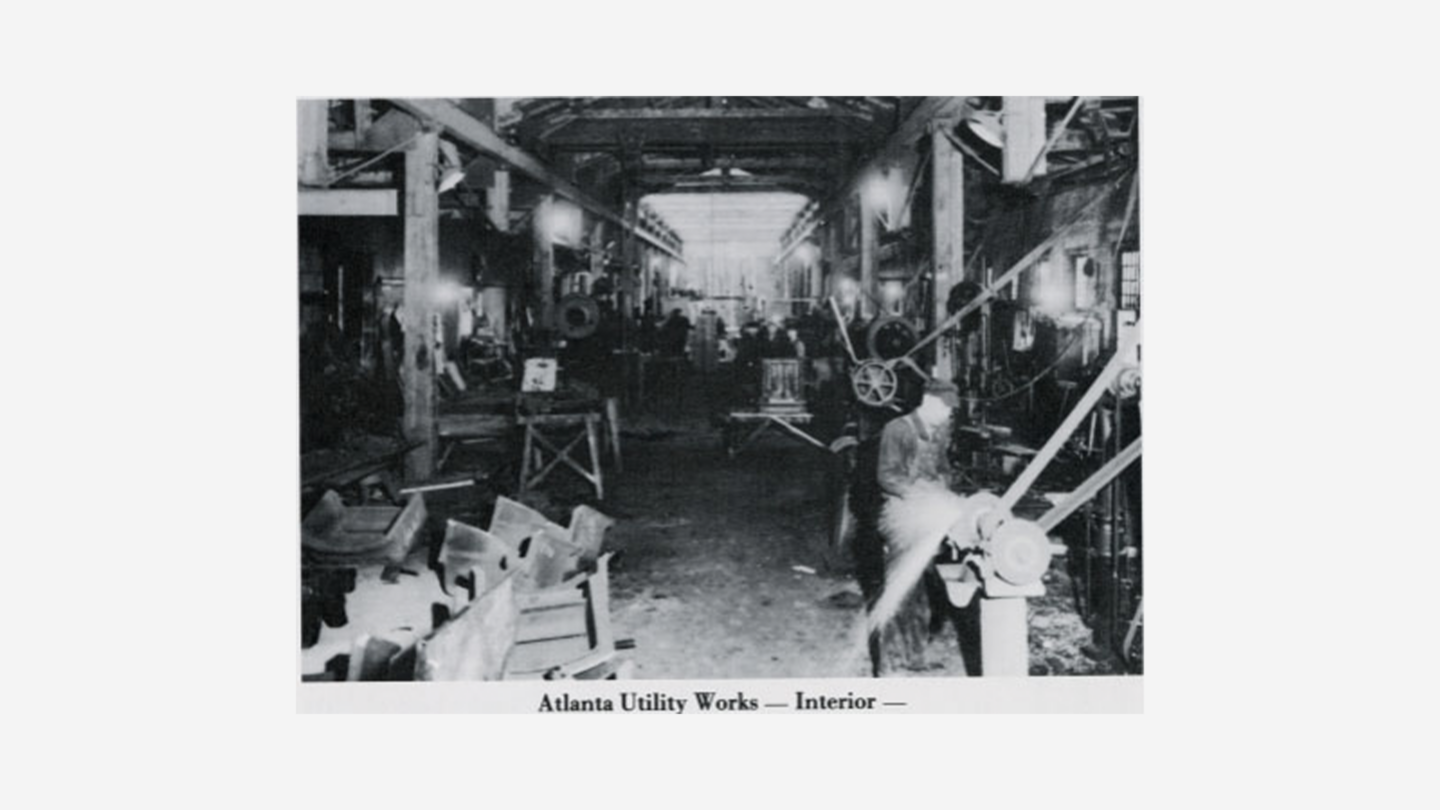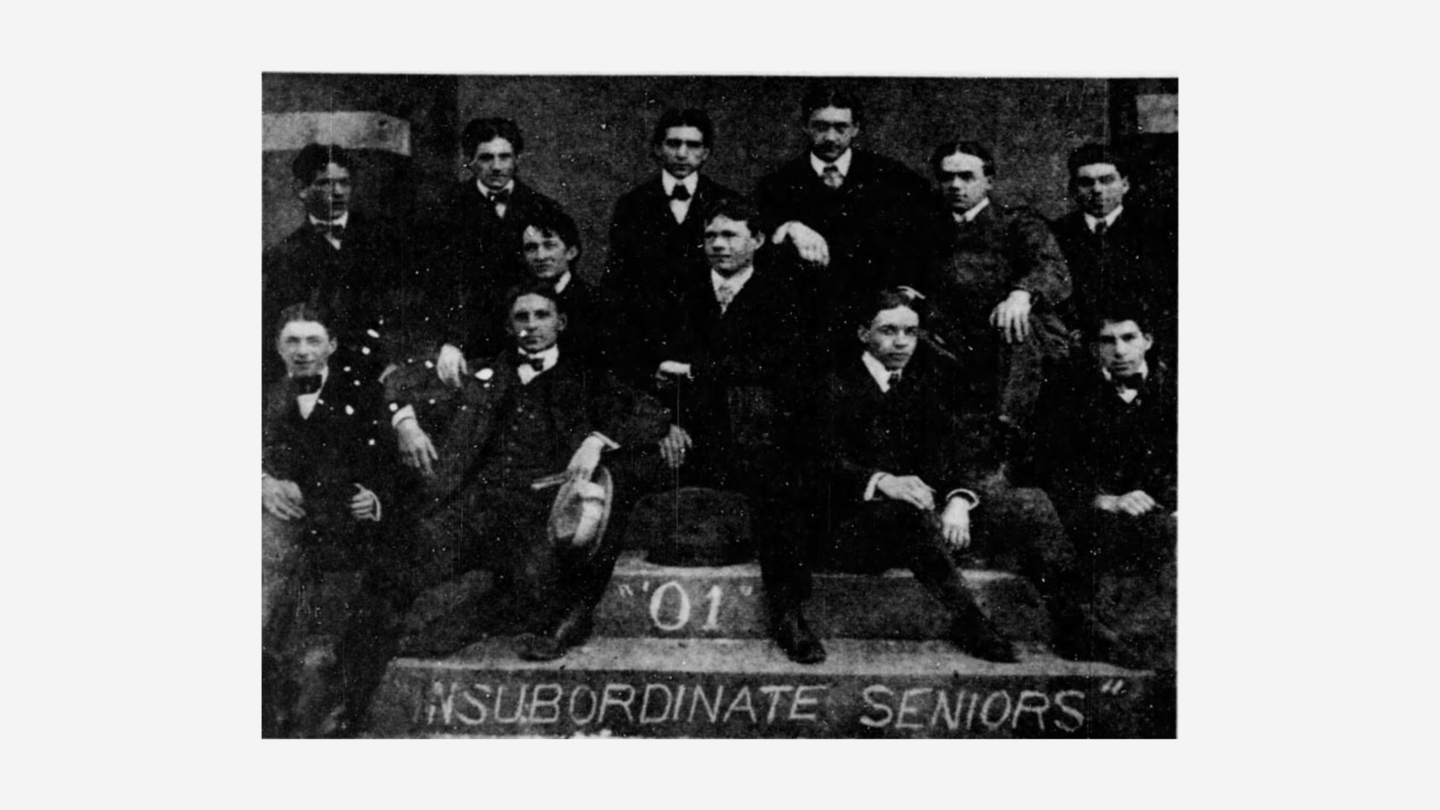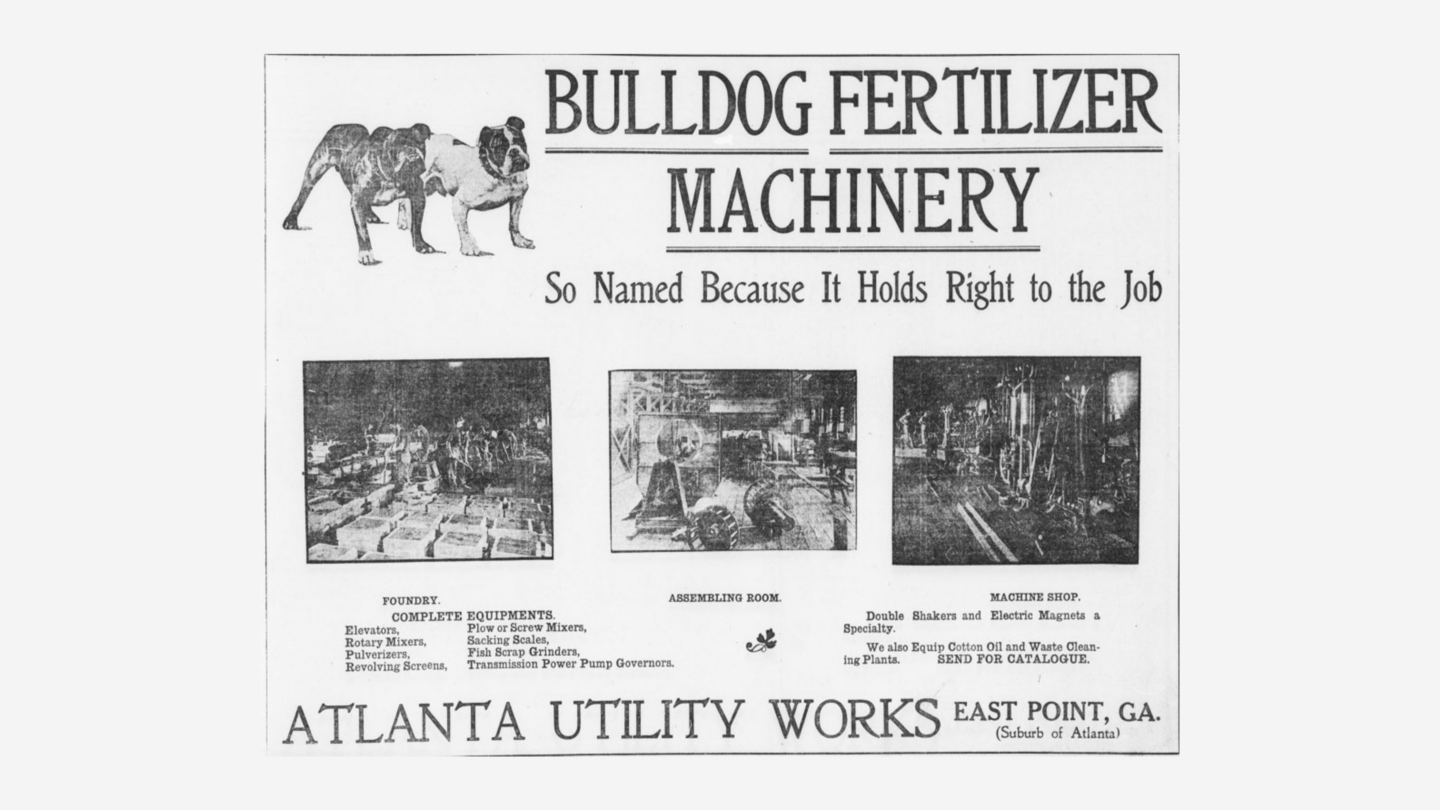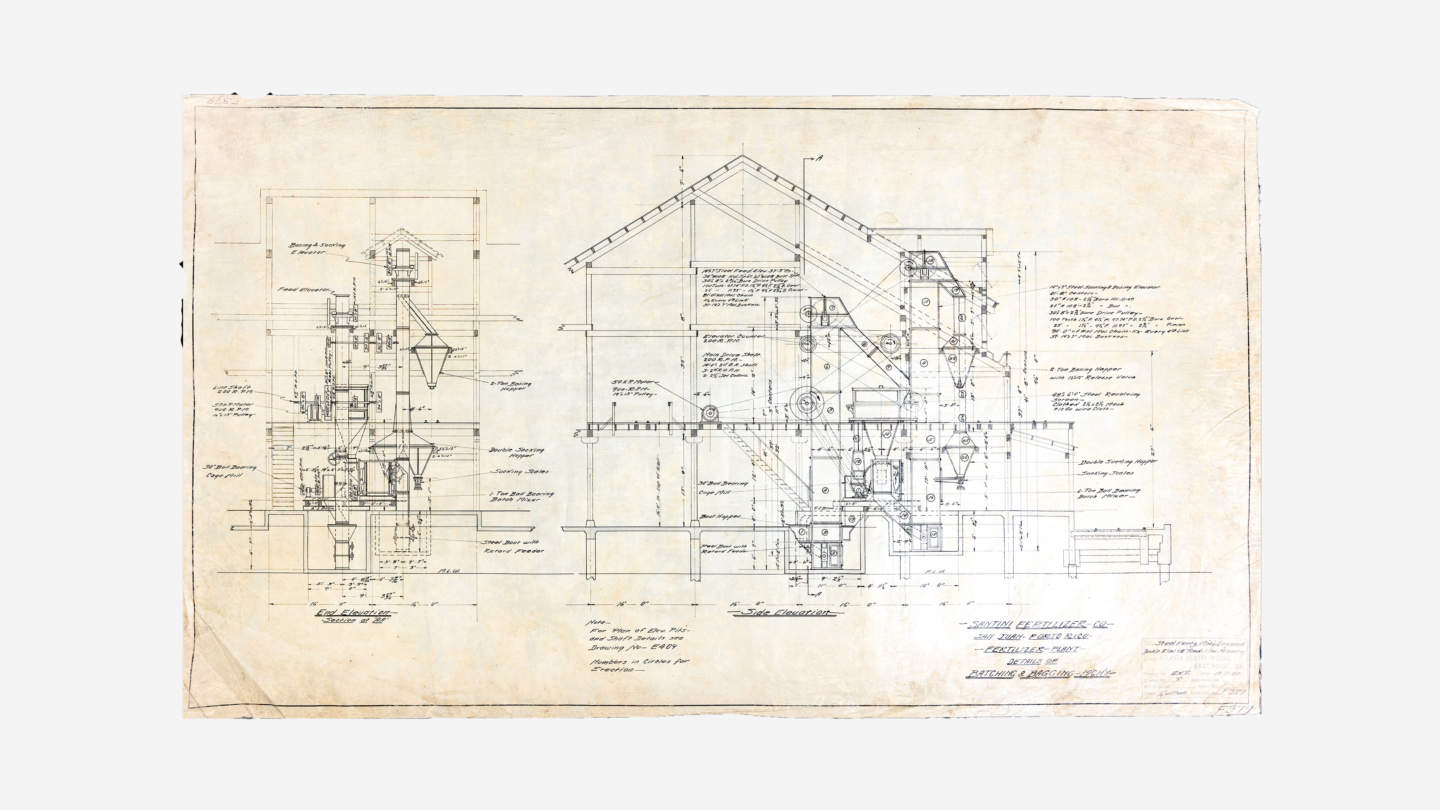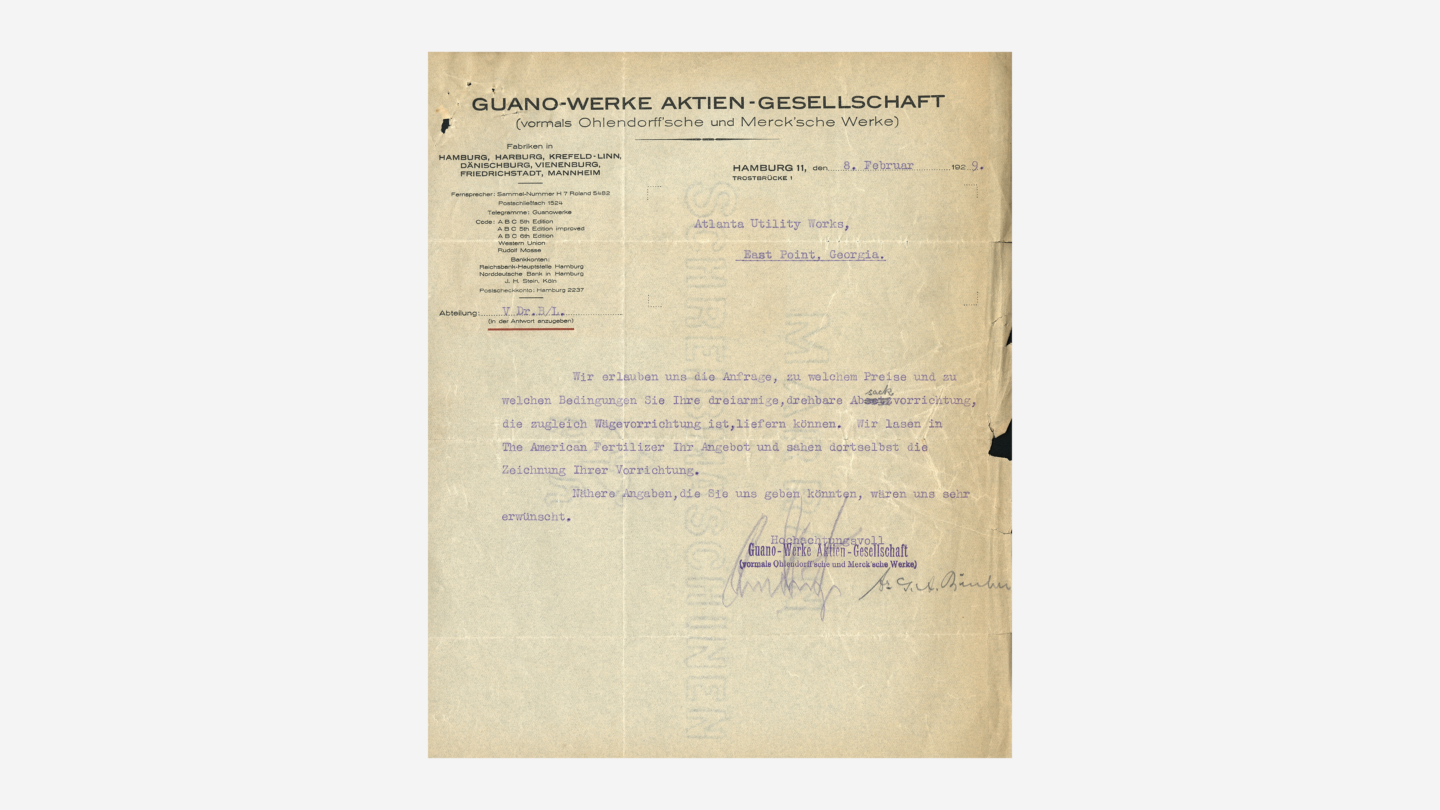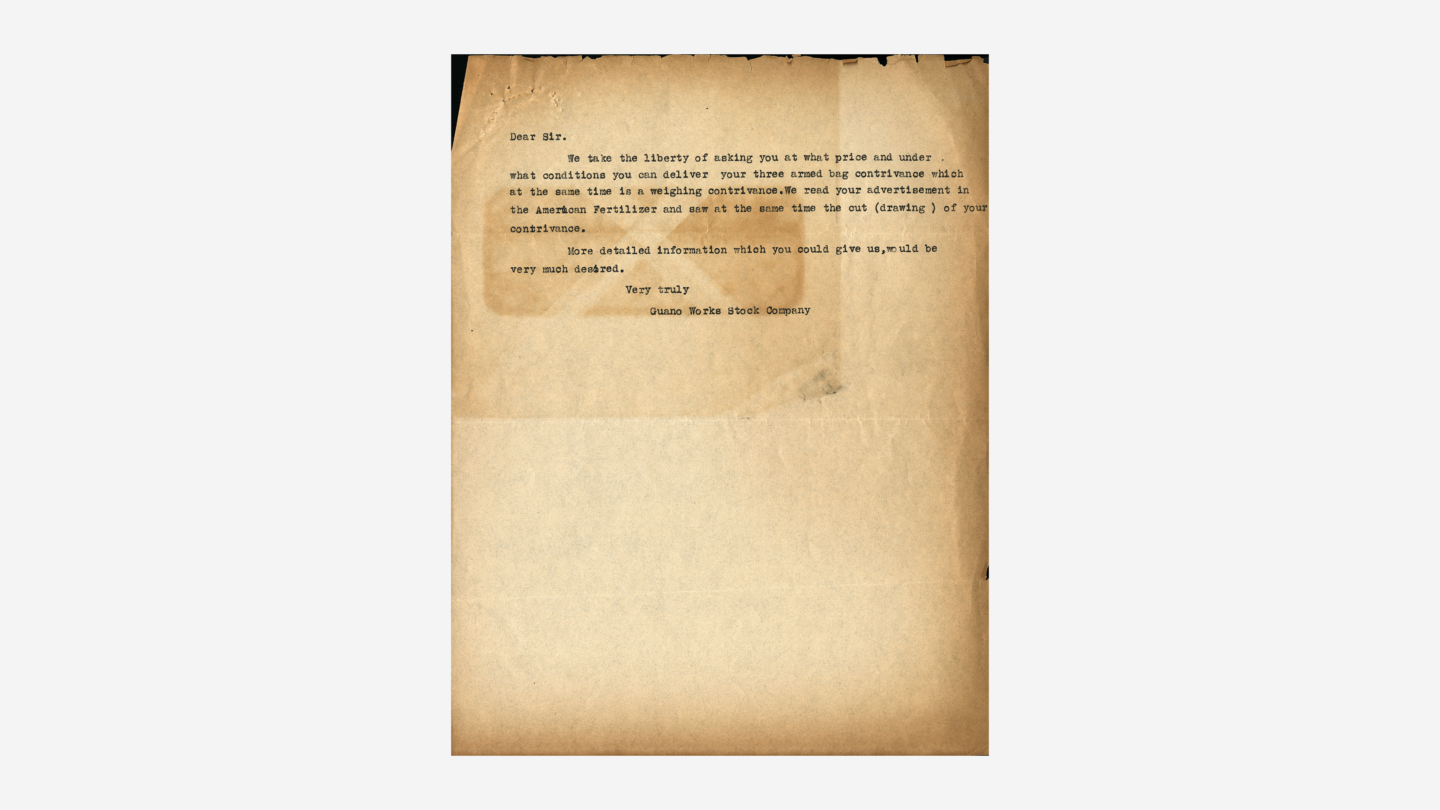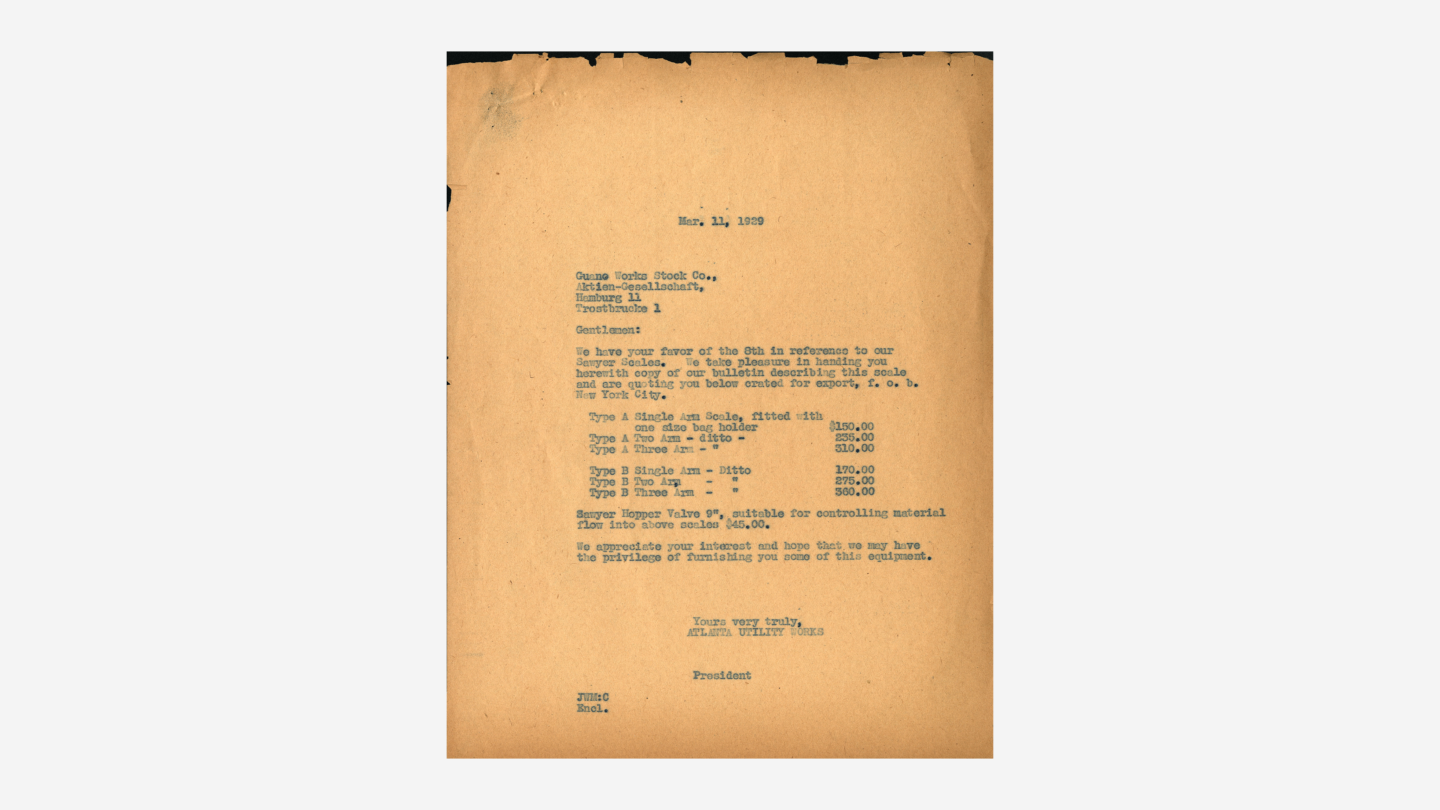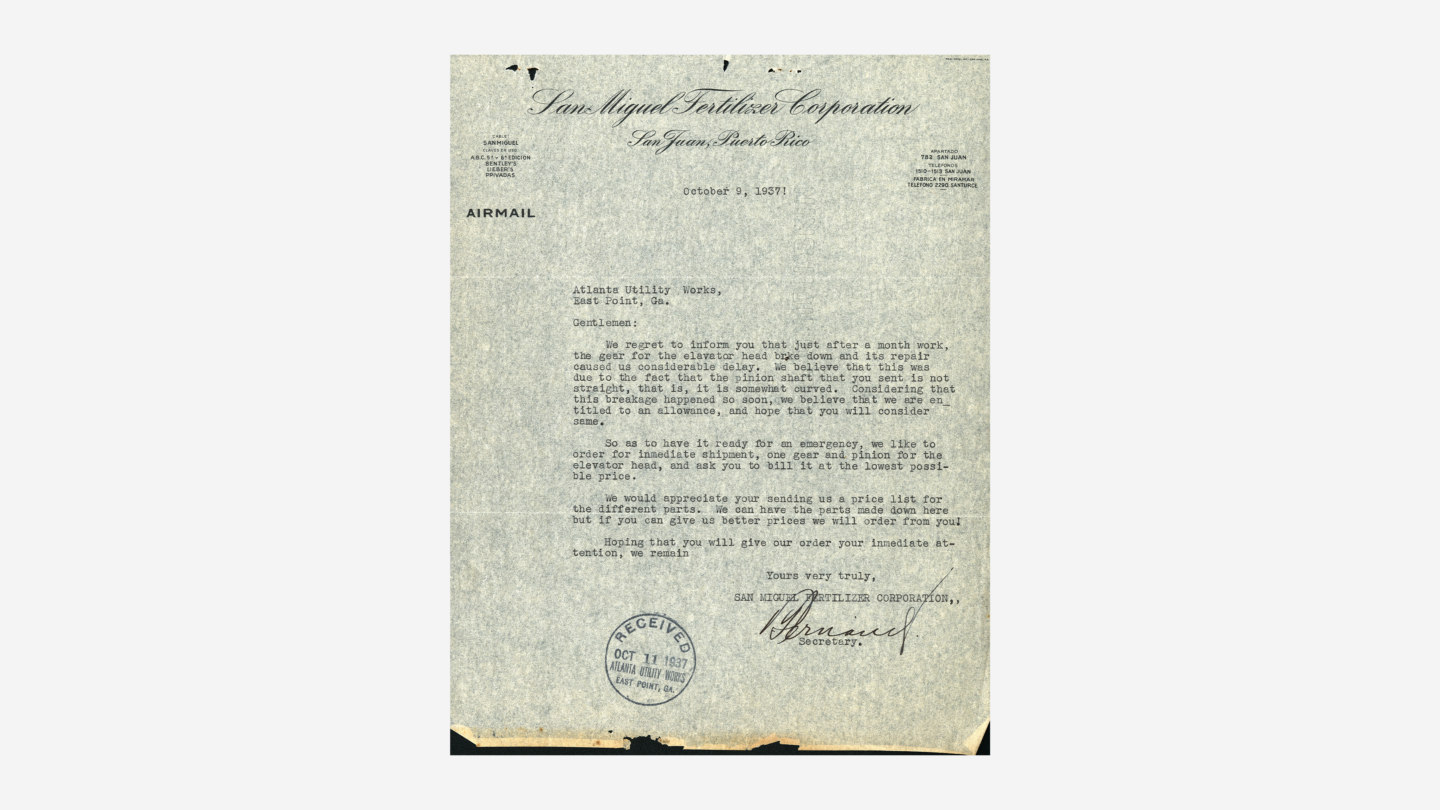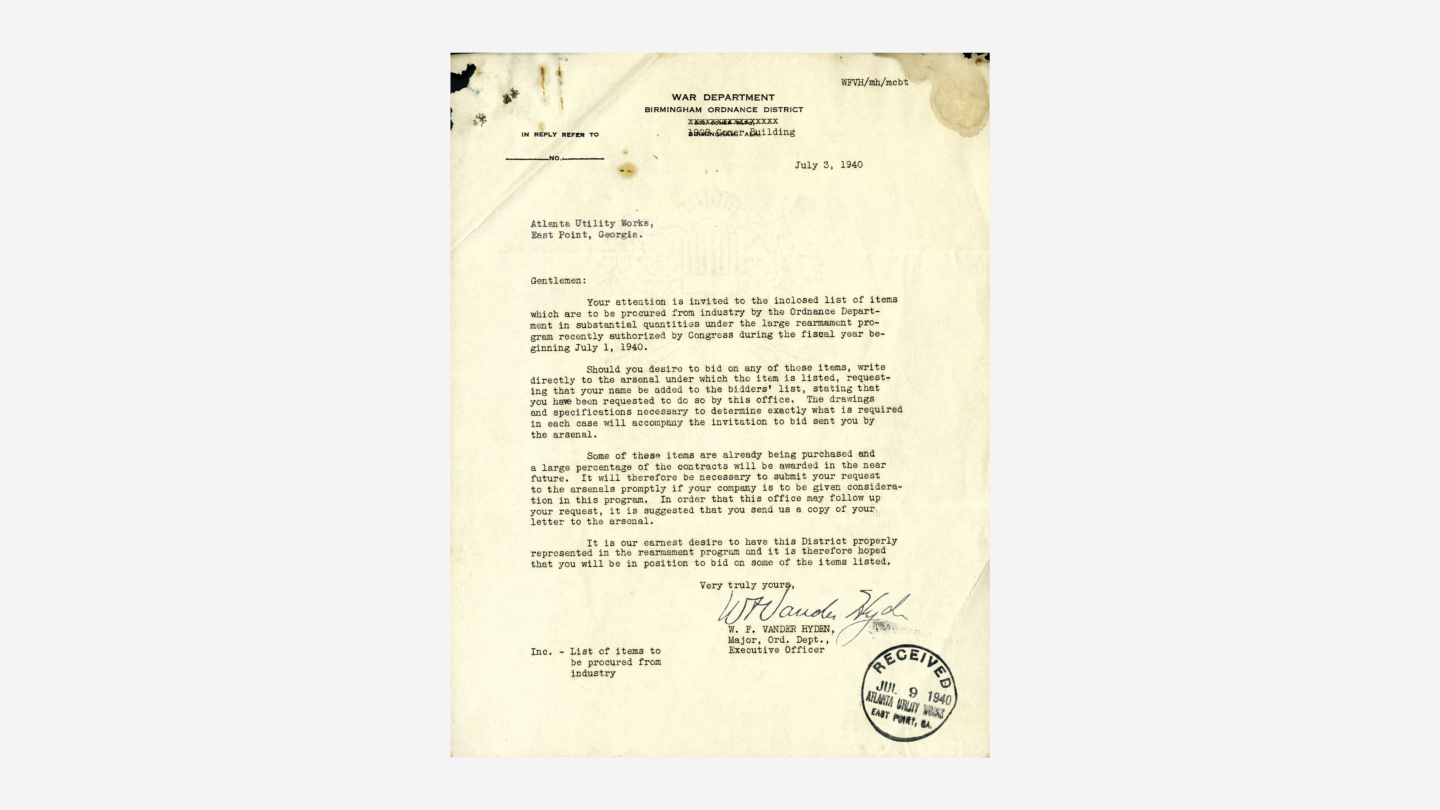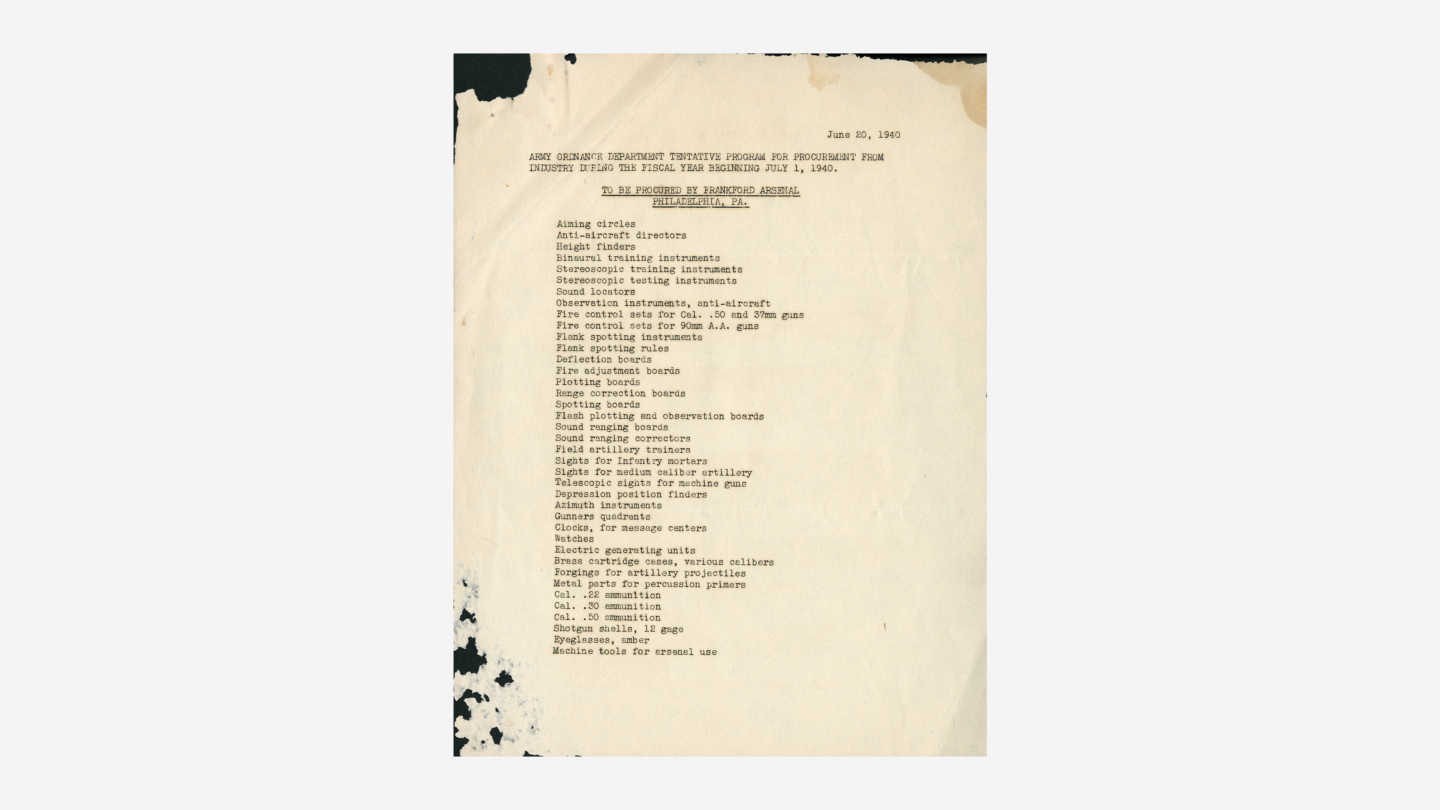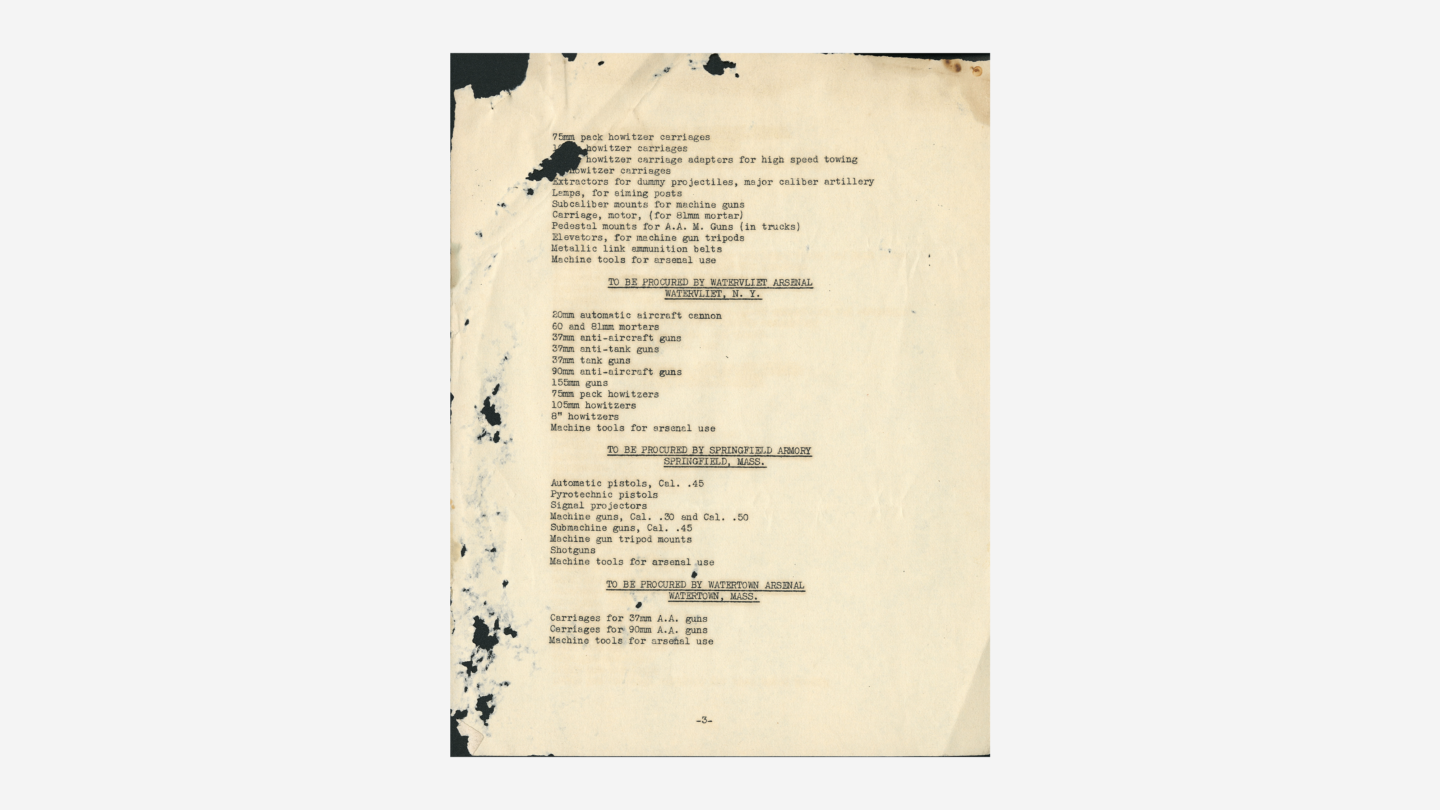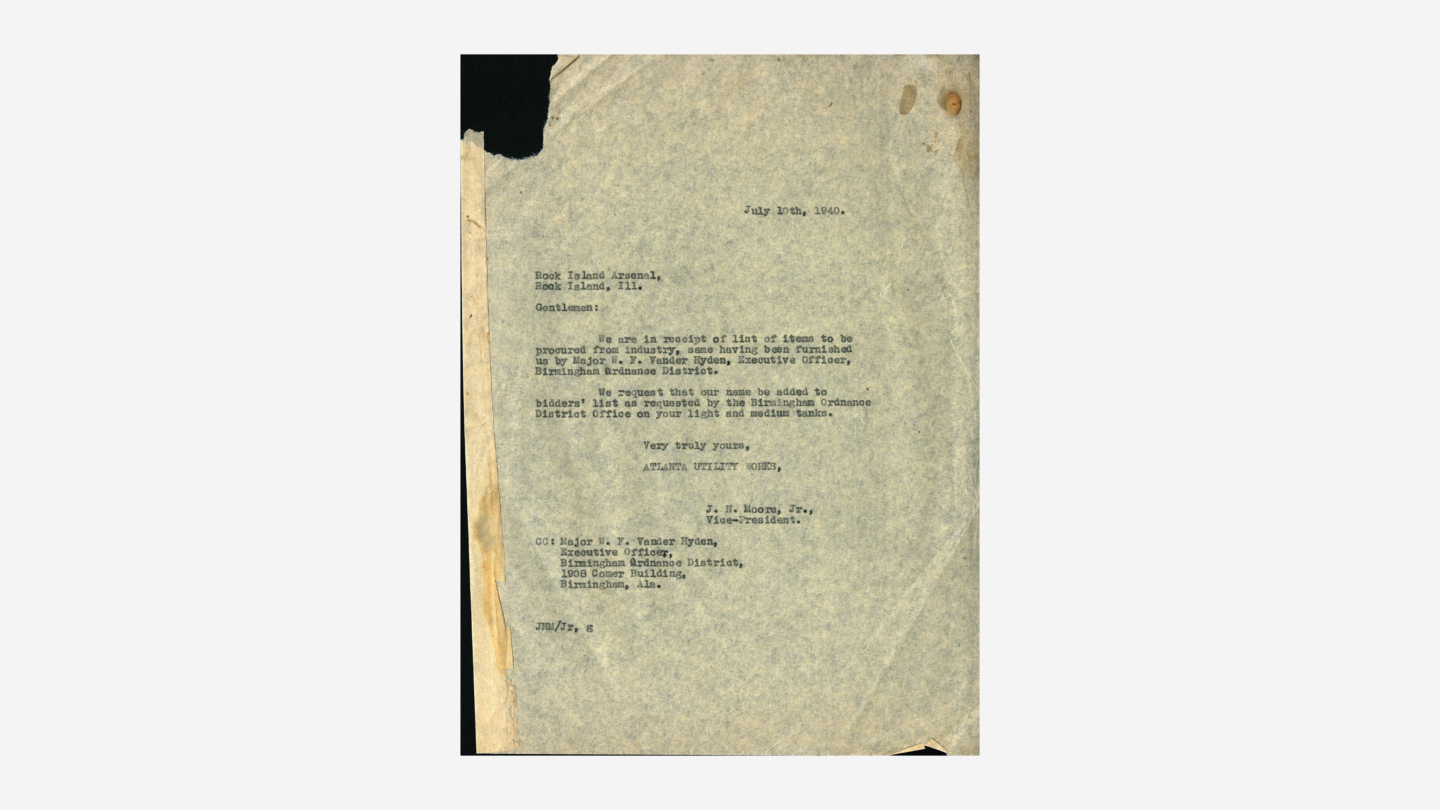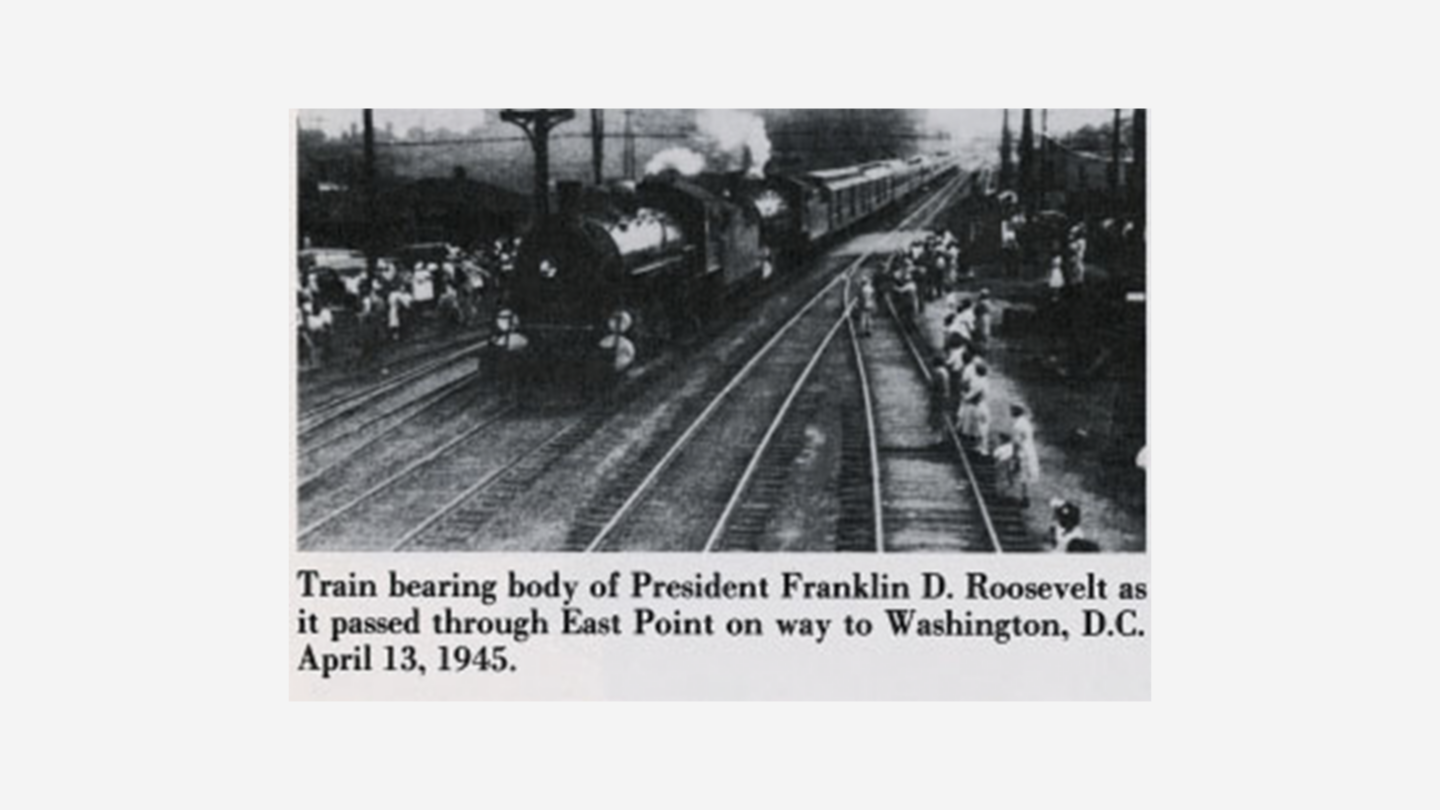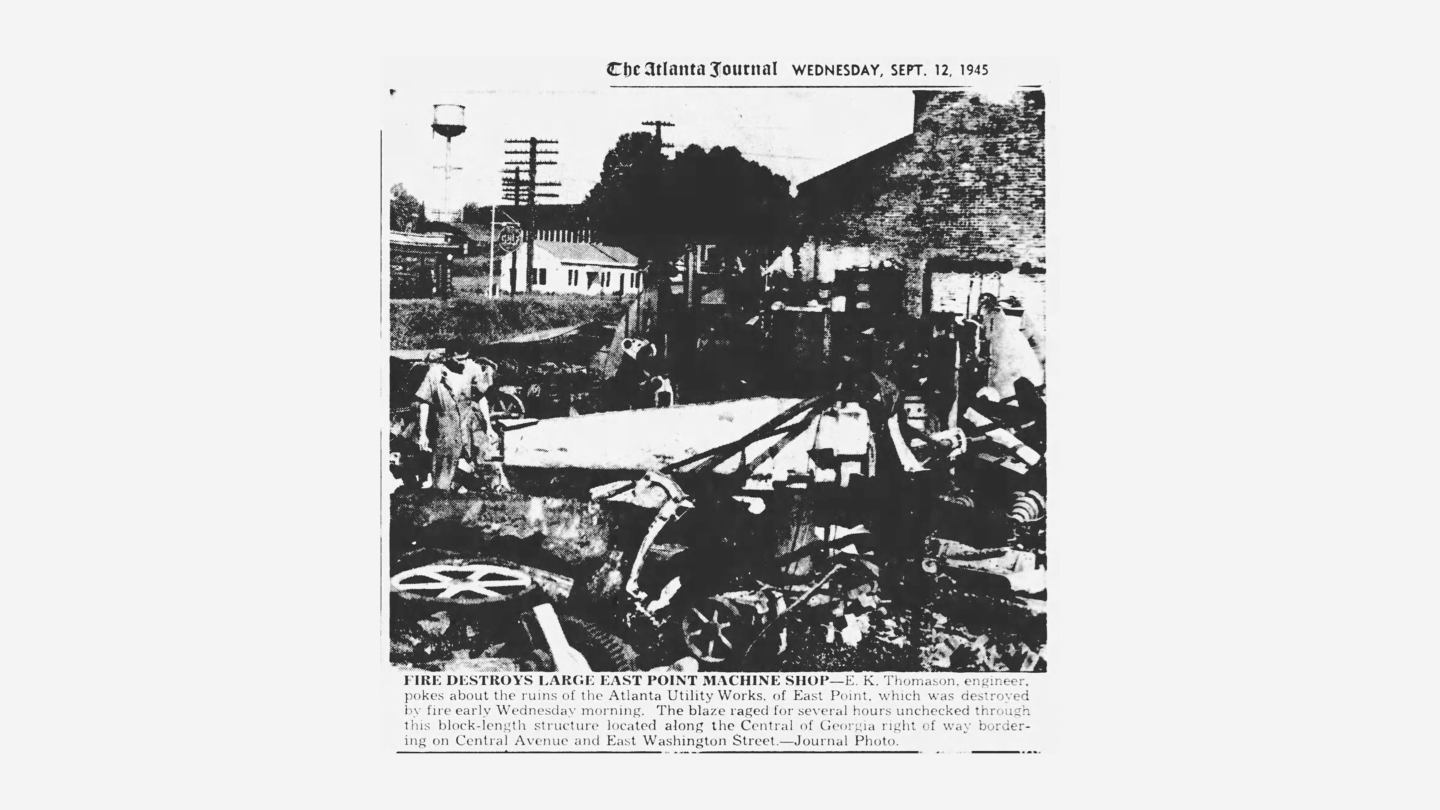It’s 2024! As part of our programs this year, Atlanta History Center is bringing back Party with the Past, an event series visiting historic sites around the city to highlight their stories.
On Thursday, July 25th, we will travel to Atlanta Utility Works, located in East Point, a longstanding pillar of manufacturing in the area. The initial founders of the machine shop began their work in 1901, within the first generation of East Point’s incorporation, and remained in the same spot for over a century. This is no small feat in the Atlanta Metropolitan Area, which constantly seeks to reinvent itself.
Over its tenure, Atlanta Utility Works proved to be a highly adaptable institution, with its founders at first establishing it in the cotton seed oil industry, before expanding to develop fertilizer equipment, building tank components during World War II, and then finding new life at the end of the 20th century as a specialist in old machinery.
Doing a full historical write up for this site was a challenge. Many records for the site have been lost throughout the years due to a series of fires. East Point has often received less attention and resources than its neighbors, and there is limited information about its early history.
However, the history of Atlanta Utility Works provides valuable insights into the community it served, and the transition of towns like East Point from pioneering town to industrial community to the suburban neighborhoods of today.
About East Point
East Point, located just south of Atlanta, got its start in 1857 as the terminus for a railroad in 1854. The Atlanta & West Point Railroad constructed a rail line connecting southern Atlanta to West Point, a small town located on the Alabama border and the end of the Chattahoochee River. It naturally made sense to call the area on the other side of the line East Point.
East Point, College Park, and Hapeville make up the “Tri-City” area of Fulton County communities south of Atlanta. Due to their relative proximity to each other and to Atlanta, there is often a significant connection between residents of these cities, though each has worked to assert their own unique identity.
While the area was slowly settled over the subsequent decades, East Point did not formally incorporate until 1887. The most thorough accounts of this era come from Samuel N. Thompson, a member of an East Point pioneer family (and younger brother of one of its first mayors, Robert F. Thompson) who in 1933 was commissioned by the East Point Women’s Club to write an account of early East Point. Thompson’s work engages in questionable judgements—his account brags that the city in 1933 has an active branch of the Ku Klux Klan, among other groups he termed civic organizations—but his book remains one of the only primary sources on early East Point life. In his account, East Point, like many towns and neighborhoods on the periphery of Atlanta, was at first known as a summer resort town where some wealthy Southerners would vacation, such as historian John Temple Graves’ father.
Starting in the 1880s and lasting well into the 1960s, East Point developed a reputation as a home for manufacturing; it was a convenient location due to its proximity to Atlanta and the rail lines that connected it. This led to a population boom as employees of these businesses moved to be close to their work, with East Point’s population peaking to be the 7th largest in the state in the 1960s.
Many of these factories opened their businesses along what is now Martin Street, which runs parallel to the rail line. Notable businesses include Blount Carriage and Buggy Works, White Hickory Wagon Works, Oak Knitting Mill, and Couch Brothers Cotton Mill, all constructed between the 1880s to early 1900s. Amongst these bigger businesses was Atlanta Utility Works, which outlasted them all.
Early Years of Atlanta Utility Works
The first patent assigned to Atlanta Utility Works, for what would later become known as the Winder Magnetic Separator. US Patent Records, Patented June 24, 1902.
There is some uncertainty about the year Atlanta Utility Works was founded. When the East Point Historical Society crafted a quilt celebrating East Point’s centennial in 1987, the patch for Atlanta Utility Works, as well as interviews from the corporate leadership of the site at the time, establishes the business as having been founded in 1898. When the Atlanta Constitution profiled the site in 1904, they stated that the business was incorporated in 1901. The first patent issued to Atlanta Utility Works was June 1902.
The tenure of the three men most closely associated with the first decade of Atlanta Utility Works was also a relatively minor part of their careers and the history of the site. However, their biographies represent the spectrum of people starting businesses in East Point at the time: wealthy Atlantans seeking to expand their assets in an up-and-coming market, the first generation of East Point families entering wealth of their own and wanting to reinvest in their hometown, and non-Southerners who wanted to make a name for themselves in the burgeoning markets of the South.
The president and treasurer was Eugene Hascal Thornton, a prominent Atlanta citizen who invested in many businesses across Fulton County. Thornton was a Confederate veteran, and the father of Georgia’s only State Librarian, Ella May Thornton. He started off in the railroad industry before marrying into the Neal family and becoming an officer in the Neal Loan and Banking Company, later serving as its leader. He does not appear to have been directly involved in the day-to-day operations of Atlanta Utility Works, and his role was likely its financier. An audit of Neal Bank by the State Bank Examiner’s office in 1907 revealed that the bank had $161,000 worth of shares in Atlanta Utility Works.
The management of Atlanta Utility Works seems to have been a partnership between two men: Daniel Connally Lyle and James Clarence Winder. The former was a well-known Tri-City figure and came from an East Point founding family. Lyle’s father, Captain AJ Lyle, owned East Point’s first general store before moving to Atlanta and making a small fortune in the real estate business. His son continued this trade but also became the secretary and general manager of Atlanta Utility Works, conveniently (perhaps intentionally) located in his hometown.
James C. Winder was the hardest to track down in the historical record. From census records, we know his full name was James Clarence Winder, that he was married to a woman named Jennie Winder (nee Jarvis), and that he was born in 1871 in Ohio. How he got involved with the business, and the story of his departure, remains unknown. Winder was Atlanta Utility Works’ chief engineer, superintendent and appears to have been the primary designer of their product lines. Coverage of the site in its early years called their most popular product the Winder Magnetic Separator, a magnetic tool used to remove metals from cotton before they were processed in cotton gins. Many of the early Atlanta Utility Works patents are in his name.
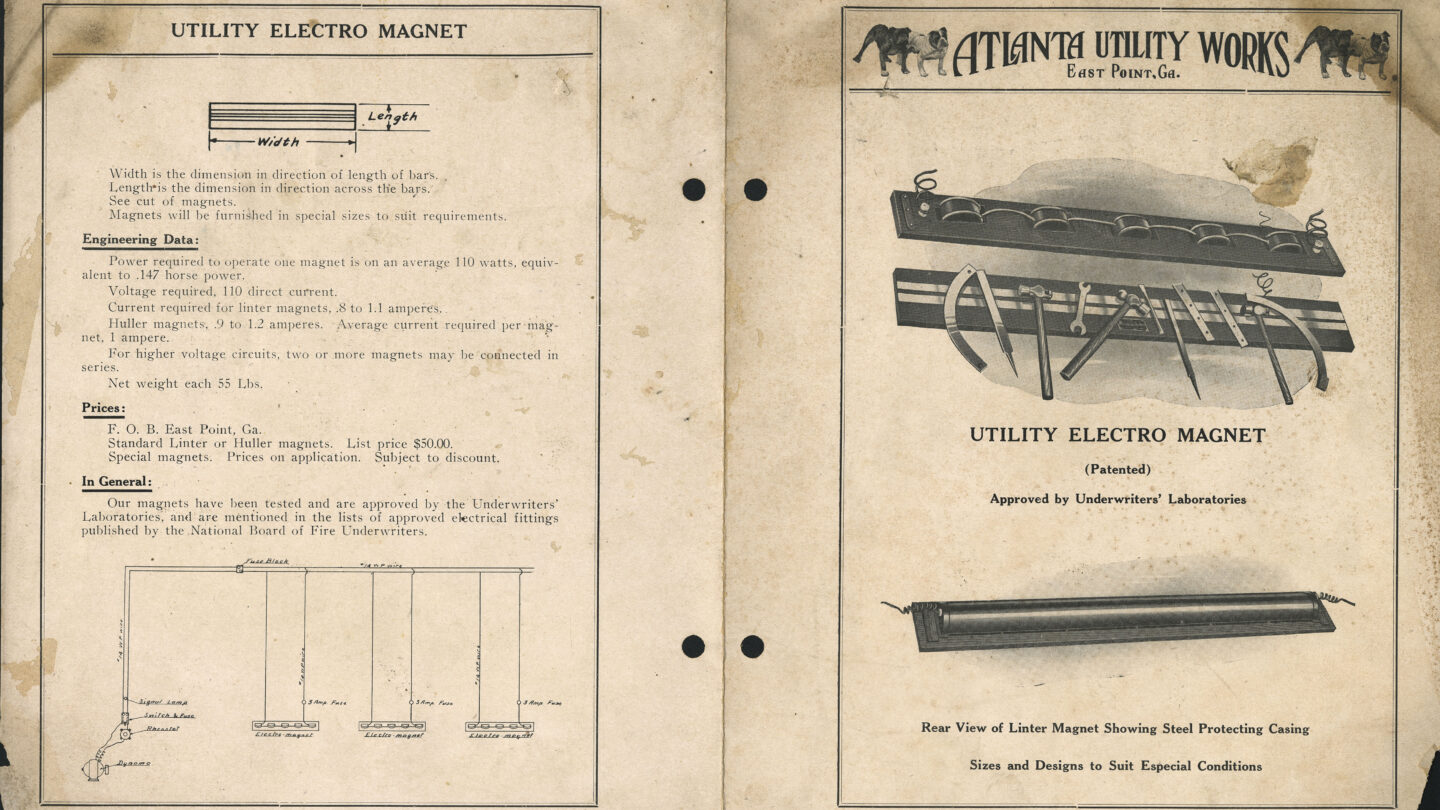
In their early years, Atlanta Utility Works was known for separators like these which were used to filter crops such as cotton where metallic items would remain hidden. This prevented these metallic items-such as nails, bolts, or scraps of metal-from destroying the cotton gins. This brochure shows a later version of the model. Utility Works Archive, Date Unknown. Images Courtesy of Kenan Research Center.
Atlanta Utility Works was an early success story for East Point. The Winder Magnetic Separator was so successful that the Atlanta Journal claims that by November 1902, within 5 months of receiving the patent, Atlanta Utility Works was three months behind on orders.
Boosters for the city would point to the business the machine shop brought in from across the South as a reason to invest in the city. In 1902, Atlanta Utility Works was chosen as a representative in an Inter-State Fair, alongside up and coming businesses like Coca-Cola. In 1904, The Atlanta Constitution published a glossy profile of the organization as part of the many reasons to move to East Point. As they developed new products, Atlanta Utility Works opened a business office on Mitchell Street in downtown Atlanta.
Lawsuit and Reorganization
On Friday, April 21st, 1905, The Atlanta Journal reported that a “firebug” (then-slang for an arsonist) attempted to burn down Atlanta Utility Works the night before. Their efforts to burn the site to the ground were foiled by Ben Banks, the night watchmen at the time, who caught the individual and shot them with a double-barreled shotgun. The arsonist escaped, and as far as we know was never caught.
This incident next gets coverage in December, when now-former employee James Winder announces his intention to sue Lyle for defamation. Winder alleges that Lyle accused him of being the arsonist and had night watchmen Banks follow Winder to his house. We don’t know for sure when Winder and Lyle fell out with each other, as the only other record of Winder during this time is in 1906, when a patent of his is approved and assigned to rival firm E. Van Winkle Gin and Machine Works, but Winder claims that by this point Lyle is actively harming his reputation and making it difficult for him to find work.
This lawsuit lasts two years, and by the end of it none of the three original team members are directly involved in Atlanta Utility Works. Lyle staged a run for Chairman of the Fulton County Board of Commissioners in 1906; he later withdrew, citing a need to “focus on his businesses”. He never sought public office again. Lyle was likely the last active founder of Atlanta Utility Works, and after his departure he remained active in Tri-City civic life and the real estate business until his death in 1931.
In December of 1907, Winder’s lawsuit was dismissed by his attorneys after the night watchmen Ben Banks refused to corroborate Winder’s account of the accusation. He later moved to Washington, Georgia, where after the 1910 census there is no record of him. As death records in Georgia were not standardized statewide until 1919, it is likely that he died sometime during that decade. In subsequent coverage of Atlanta Utility Works, he is never mentioned again.
Finally, Thornton’s primary business, Neal Bank, failed in 1907. It was audited by the state government. Thornton himself was later indicted and convicted for bank fraud after he lent more than 25% of the Neal Bank’s stock to himself, though his conviction was eventually overturned. In his later life, he became active in Confederate veterans’ organizations before his death in 1921.
Middle Years; Becoming a Family Business, Tanks, and Fire
After the departure of the original three founding members, Atlanta Utility Works reorganized, and it became a feeder organization for recently graduated Georgia Tech engineers. This included Walter D. Nash, initially President of Atlanta Utility Works, who patented much of the technology that led AUW to expand to fertilizer machinery, Ernest K Thomason, who would become Atlanta Utility Works’ longtime chief engineer, and James Wayne Moore, who would succeed Nash as President and put Atlanta Utility Works in the hands of his family for the rest of the business’ existence.
Moore, originally from nearby Hapeville, was valedictorian for Georgia Tech’s Class of 1901. He was also a member of “the insubordinate seniors”, a group of seniors that year whose graduations were delayed after they opted to skip the first few days of their last spring semester to spend New Year’s with their families. He eventually took over as President of Atlanta Utility Works and remained so until his death in 1963.
Early in his tenure, Moore’s cousin, Savannah-based James Norris Moore Jr., bought the Atlanta Utility Works property for $6,575, or around $150,000 in today’s dollars. This purchase was likely an acquisition of the business by the Moore Company, as James Norris Moore Jr and his father immediately took on roles in Atlanta Utility Works. His son, James Norris “Jimmy” Moore III, was also Atlanta Utility Works’ last president.
Over the next decade, the company expanded dramatically. Their business went beyond the Southeast, as they built factory equipment in Puerto Rico for New York-based sugar companies and found clients in places as far as Germany and Japan.
The machine shop pivoted to producing fertilizer machinery equipment as well. According to an Atlanta Constitution interview conducted in 1997, this seems to have been a practical consideration; at the time, East Point had at least six fertilizer plants.
A letter requesting a quote on replacement parts from Elberton Oil Mills, located along the border between Georgia and South Carolina. Utility Works Archive, August 28th, 1939. Images courtesy of Kenan Research Center.
During that time, Atlanta Utility Works also played a key role in the East Point community. As a machine shop with talented engineers, they assisted in basic repairs for the businesses surrounding them to earn extra funds. James Wayne Moore was elected the first President of the East Point Lions Club in 1929. As early as 1930, Atlanta Utility Works was donating and contributing to ads in Southern Israelite, a publication for the Atlanta Jewish community that later became the Atlanta Jewish Times. During World War II, Atlanta Utility Works helped raise funds for the Red Cross and sponsored campaigns supporting Victory Bonds.
It was also during World War II that Atlanta Utility Works’ business model changed again. It started in July 1940, when Atlanta Utility Works received an open letter from the Birmingham Ordnance District of the United States War Department. The war was still in its early phases—so early that the US wasn’t even involved yet. Pearl Harbor was almost two years away. The Lend Lease Act, granting the United States government the power to distribute to its allies, would not be signed into law for another year. The “destroyers-for-bases” deal, while being discussed, wasn’t signed off on until that September.
In anticipation of the growing war in Europe, in June 1940, Congress approved of an expansive re–armament program aimed at preparing the United States in the event of war. As part of this program, local manufacturing firms were asked to bid on contracts to produce weapons, ammunition, and vehicles.
Atlanta Utility Works bid on the opportunity to manufacture tanks for Rock Island Arsenal, an Illinois-based army installation. Though they failed in their initial bid, in May 1942 they received a $178,000 contract from the United States Army to build armor for vehicles for $178,000; in today’s dollars, an almost 3.5-million-dollar contract. Post-war interviews from employees at the time suggest that this armor plating was for tank turrets.
Atlanta Utility Works was one of only two East Point businesses to receive a major military contract during the war. Atlanta Utility Works got to work, sending in orders for parts from firms around the country, putting out ads for “CAPABLE planer, boring mill, lathe, shaper, and radial drill operators” to help assist, and completed the contract by April 1943.
A set of promising post-war contracts were derailed when a fire broke out in September 1945. According to coverage by The Atlanta Journal, the fire was not put out for several hours, burning the machine shop to the ground.
Later Years
Atlanta Utility Works quickly rebuilt the structure we know today and continued to operate for another 60 years. After the 1950s, the business began to decline. Reflecting on the business in 1997, then-President James Norris “Jimmy” Moore III partially blamed this on the boll weevil, which ravaged crops across the South and led to the decline of many farm-related industries. The machine shop transitioned once again to machinery for heavy industry but remained below the radar in comparison to their pre-war prominence.
Key staff members began to die- James Wayne Moore died in 1963, followed by James Norris Moore Jr. in 1972. The business was not bringing in many new employees, and those they had were often focused on other ventures. James Wayne Moore Jr, often called just Wayne Moore, became City Manager of College Park and Chief Engineer of East Point. Thomas Gray Moore, a son of James Norris Moore Jr. and onetime Vice President of Atlanta Utility Works, was elected to Georgia’s State Senate, representing the North Fulton, eastern Cobb County, and Paulding County area. That left the day-to-day operations of the shop to Jimmy Moore III and a team of seasoned engineers, many of whom had been there for decades and were advanced in age.
That age became an asset, and the business developed a reputation as one of the few sites with engineers specialized in repairing older equipment. In the 1997 Atlanta Constitution interview, Moore explained that the firm is contacted to “make a new piece for a machine or figure out a way to salvage the old parts and make them work again”. Their engineers serviced East Point and the rest of the South from then until the end of its tenure.
The best example of this is Ernest K. Thomason, an engineer who had the longest tenure at Atlanta Utility Works of any employee. Thomason started working at Atlanta Utility Works in 1912, as part of the co-op program—he played football under John Heisman at Georgia Tech while studying mechanical engineering and working at the machine shop. He became a valued member of the East Point community. He was a member of the East Point Rotary Club, who honored him for over 20 years of service. In 1982, 70 years after he first came to East Point, he was a guest speaker for the East Point Historical Society, formed in 1979 by the East Point Women’s Club to help highlight the story of the city.
Though he moved to DeKalb County in his later years to be closer to his family, he remained involved in Atlanta Utility Works and East Point until his death at the age of 98 in 1989.
Atlanta Utility Works Today
After much of the original staff retired or died, Atlanta Utility Works was sold in the mid-2000s and changed hands a few times before the current owners, Cultured South, purchased the property. In that time, Atlanta Utility Works also played a role in one of the new features of East Point industries: film and television. East Point is sandwiched between Hartsfield-Jackson International Airport and many of the most notable film studios in Atlanta and has used that fact to serve as a filming location.
Atlanta Utility Works is no stranger to this effort. It is probably best known today as a site for television productions like Stranger Things and Ozark. It has also found new life as an event space and brewery for Cultured South.
Party with the Past: Atlanta Utility Works will be on Thursday, July 25th, from 6:30–9:30 pm. We will get a chance to use the site’s new role as an event space to learn about the old roles it has held throughout our city’s history. We hope you will join us.
Special thanks to Andrew McQuade/@utilityworksarchive for providing some of the resources used in this blog post.
